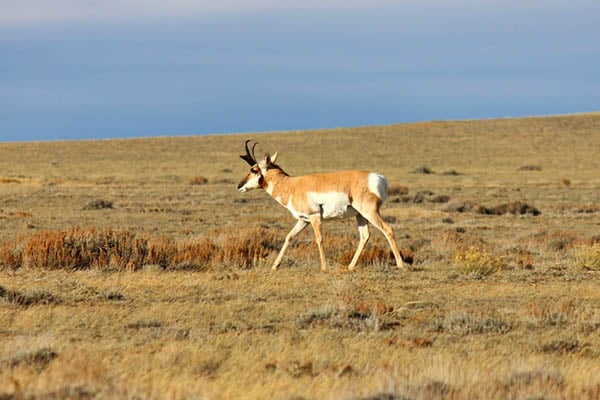
Last Updated on
By Tony Martins
Known as the speedburner of the western plains, the pronghorn is an interesting animal, and truly an original. They are often called antelope, due to similarities with the true antelopes of Africa and Asia, or goats, presumably because they have a gall bladder like goats – or not-so-scientifically for their preference for sagebrush when other seemingly more succulent forage is available. Nevertheless, these deer-like animals are neither antelope, nor goat, despite their scientific name, Antilocapra Americana which means “American antelope goat.” The pronghorn is entirely unique on this planet, as the sole surviving member of the ancient Antilocapridae family that dates back more than 20-million years to the Pleistocene Epoch – a time when the apes arose and diversified to become widespread in the Old World. Distinguished as the only animal with branched horns, as well as the only animal that sheds its horns as if they were antlers, the New World pronghorn has been a North American resident for more than a million years. With remarkable eyesight and speed as their primary defenses, pronghorns can spot danger up to 4 miles away, exceed 50 miles per hour in short sprints, and sustain a blistering pace of 30-40 mph for miles… just ask any hunter who has spooked the fastest running animal in the western hemisphere!
Pronghorns inhabit the treeless plains, basins, chapparal and deserts of western North America – from the southern prairies of Alberta and Saskatchewan in Canada, southward through sixteen western states in the U.S. and down into northern Mexico. It has been estimated that 35 million pronghorns made their home on the North American range prior to European colonization, second in numbers to only the iconic American bison. By 1924, this number had plummeted to less than 20,000. Since pronghorns cannot leap fences like deer, fenced rangeland hampered their migration from summer to winter feeding areas as well as seasonal access to water and shelter, and this took a toll on survival. Conservation efforts to preserve the pronghorn as a highly prized game animal have helped to stabilize and revitalize the general population across much of their historic range. Today, pronghorns are estimated to number around a million strong, and once again are considered by many to be the second most numerous game species in North America.
Habitat, Forage and Movement
Dry grasslands and prairies, treeless foothills, brushlands, sage-scrub or chapparal and deserts are the habitat types where pronghorns flourish, at elevations ranging from sea level to more than 11,000 feet. They prefer open range and rolling hills where their eyesight provides an advantage, as well as open river valleys and coulees with watering holes. Pronghorns feed on a wide variety of plants, eating grasses like cheatgrass, wheatgrass and clover as well as the stems and leaves of forbs and shrubs. Their diet may include cacti in some areas, and sagebrush is an important browse particularly in winter. Forbs with high water content are preferred in the summer diet, and pronghorns don’t seem to need much water for drinking when the moisture content of their forage tops 75%. In dry areas and dry seasons however, pronghorns are typically found within a mile or two of water, and may drink up to 3 liters each day.
Pronghorns share habitat with domestic sheep and cattle throughout most of their range and thus, are forced to compete for forage and water. Land managers recognize that pronghorns can actually improve rangeland because they eat noxious weeds. Their preference for forbs and browse allow them to flourish in areas that have been overgrazed by cattle. Sheep however pose a problem in some areas, as they will typically eliminate much of the vegetation the pronghorns prefer, and this has been documented as a contributing factor in some winter time die offs. Another rangeland issue for the pronghorn is fencing constructed to contain cattle and sheep, which often restricts their movement and thus can result in dehydration and even starvation.

In addition to being a fundamental safety mechanism, the vaunted speed and endurance of pronghorns allows them to search for food and water over great distances. This is particularly important when a primary food source fails, during times of drought, and when unseasonal snow prevents foraging in the northernmost parts of their range. Their speed comes at a price, however. As the limbs, joints and other skeletal elements in the pronghorn have evolved to become highly specialized for cursorial movement, their ability to jump has been compromised. It’s often said that pronghorns can jump, but prefer instead to scoot under or push their way through fencing. And some do jump – but poorly in comparison to other ungulates because through evolution, they have lost the suspension mechanism from their joints as commonly found in cervids (deer), in favor of speed.
Social Interaction and Breeding Behavior
Pronghorns are gregarious animals, living most of the year in groups that range in size from 5 to 50. During winter, especially when food is scarce, they may gather in groups of 100 or more. Older mature bucks are often solitary animals for most of the year, except during breeding season when they may gather harems of up to 15 does. Bucks often run in circles, jump around wildly and shake their heads from side-to-side releasing pheremones to attract potential mates. Dominant bucks will mark and defend their territories from as early as March, through the end of the rut in early October. Battles between tending bucks and rivals are common, rarely lasting more than a couple of minutes, but often ending with injury.
Breeding takes place from mid-September to October in the north, and from late July to October in the southern parts of their range. Pregnant does deliver 1 or 2 fawns in the spring, and all births in a given area are synchronous, meaning all fawns are born within a few days of each other. Within minutes after birth pronghorn fawns called “kids” can stand on their own, and usually begin nursing in an hour or two. A few days after birth young pronghorns can outrun a human, but are still too weak to keep pace with adults. Mothers consume the excrement of their young to reduce the chance of detection by predators. Kids are hidden in vegetation and remain motionless while their mothers go off to forage – which may be as much as two miles away. At this stage young pronghorns are vulnerable to kidnapping by “wanna-do-good” but ignorant humans, who assume when encountering a pronghorn fawn with no does in sight that it has been abandoned. Wild animal rehabilitation centers in pronghorn country must deal with this issue each spring. Within a few days of birth young pronghorns are strong enough to travel and forage with their mothers, and they often join a nursery band with other does and kids.
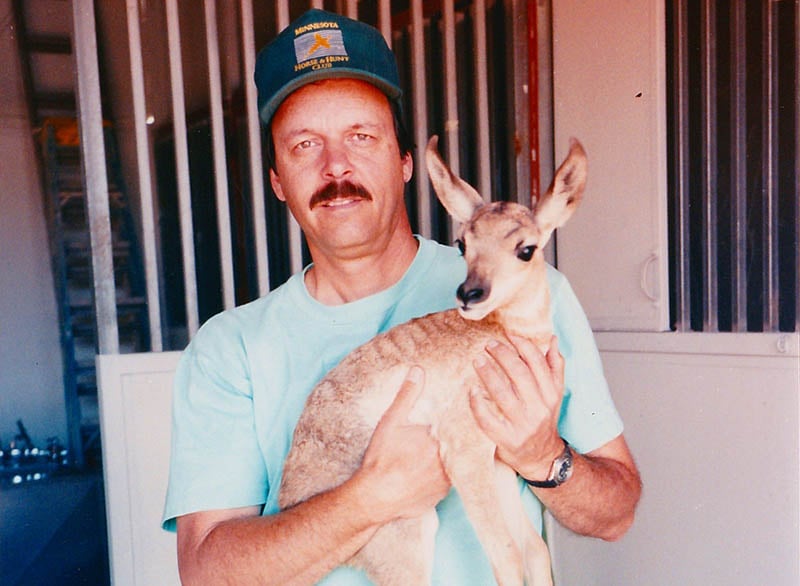
Pronghorns communicate through sight, sound and smell. They snort when surprised, and flare the white hair on their rump and the mane on their neck when alarmed, to signal others in the herd of potential danger. Kids call to adults with a high-pitched bleat, similar to that of a deer fawn. Scent is used extensively in pronghorn interactions. Both sexes have rump glands and interdigital glands, and bucks also have a scent gland below each ear and on their back. Scent is used to mark territories and discourage intrusion from other pronghorn bucks on claimed territory, to attract potential mates and identify a receptive mate, and to warn of potential danger.
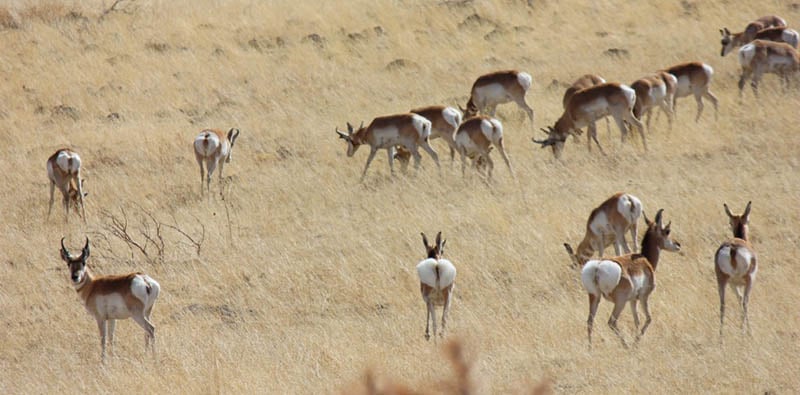
Hunting Tactics
Pronghorns are one of the most enjoyable of all North American big game animals to hunt. They prefer to use open country, so they are comparatively easy to locate, and this translates into high success rates for hunters – in the range of 70-90%. Since most hunts for pronghorns take place during late summer or early fall, weather is rarely an issue and often pleasant. Looking over a distant herd of pronghorns, and then formulating a plan to move into shooting range for the chosen weapon without spooking them is the essence and the challenge of hunting these eagle-eyed speedsters.
The spot-and-stalk approach undoubtedly accounts for more pronghorns than any other hunting method. With pronghorns on the wide open prairie, “glass-and-stalk” would be a more appropriate description of this tactic, and a good binocular and/or a good spotting scope top the list of essential equipment. Hunters should look over the topography carefully, and then plan their stalk to take advantage of available cover. The operative word here is available. For example, small cuts, washes and draws often run through open range that otherwise appears featureless, and these may provide just enough cover for the observant hunter. And, pronghorns often share the range with cattle as noted earlier. I have used cattle for cover to approach within shooting distance of pronghorn on several occasions, and this tactic netted a wary old buck for my partner on a muzzleloader hunt in Arizona. During the rut, it is often much easier for a hunter to stalk close to a pronghorn herd, as the animals will typically be preoccupied with rutting displays.

The ambush approach to hunting pronghorns is popular, particularly with bowhunters and in arid country where the animals will visit a water source daily. Pit blinds dug into the ground are highly effective and so are natural blinds, but portable ground blinds are also quite popular. If possible, it’s best to setup the blind well in advance of the hunt, as it may take a few days for the animals to lose their fear of the new and unfamiliar intrusion on their domain. Another tactic that has gained popularity in recent years is the use of decoys. Bowhunters can often sneak into range by carrying a lightweight decoy in front as they approach. When pronghorns are actively rutting, a dominant buck will often approach a buck decoy, intent to drive off the potential rival. Caution: Buck decoys should be used with extreme caution during rifle hunts, particularly on public land.
An interesting and highly effective technique is the cattle decoy. Larger than a pronghorn decoy, these can provide hiding cover for a couple of hunters on open rangeland where both cattle and pronghorns roam. Pronghorns are naturally curious, and hunters who capitalize on this characteristic are often successful – both with decoys, and with a “flagging” technique. Carefully waving or displaying a white flag while hiding to gain the attention of distant pronghorns will often cause them to come closer to investigate. I have flagged pronghorns – both bucks and does – from as far as a half-mile away, bringing them in to less than 100 yards with a simple white handkerchief.
Hunting Equipment
Good quality glass is important for judging bucks at a distance, as well as picking out topographical features that can be used for cover while stalking. The combination of a lightweight 8×32 or 10×42 binocular with a 45x spotting scope is ideal for the hunter who stalks in search of a trophy, as judging the trophy quality of a pronghorn buck is notoriously difficult in the field. Bucks with good horn mass and length, sporting prongs that start above the ears are trophy caliber. A laser rangefinder is another important tool, as most pronghorns that are missed are overshot with both rifle and bow. These animals are not large – averaging less than 100 lbs. – and judging distance on the open range can be difficult. The stalking hunter should also consider kneepads and gloves, as crawling is often necessary, and the ground in pronghorn country is typically carpeted with stickers and rocks and various creepy crawlers.
Flat-shooting rifles are often touted by writers as important – but not by this writer. The importance of “flat-shooting” is overrated in my opinion. I have dropped a number of pronghorns in their tracks with a single shot from a muzzleloader, which is one of least flat-shooting of all hunting rifles! More important is a rifle you can shoot accurately in the wind, as this is almost always a factor when hunting open rangeland. Pronghorns are not difficult to kill, so most any caliber will do. Low-recoiling calibers from .243 to .270 shooting bullets that expand quickly are ideal. Magnum calibers and deeply penetrating bullets are unnecessary. A common misconception is that long range shooting is necessary for pronghorn hunting, but truth be told; most shots on pronghorns are 150 yards or less. A set of shooting sticks or a bipod attached to the forend of the rifle is handy, as shooting from prone or kneeling positions is often the best bet in open country.
The equipment necessary to process the animal after the kill is possibly more important than the equipment necessary to hunt them. Contrary to the common perception that pronghorn meat is “goaty” or “gamy” it is actually a delicate, finely textured, delicious venison. Unfortunately, the meat is easily contaminated with the musky oil from scent glands on the animals – most notably the gland on the back of the buck. This is difficult to avoid while processing, particularly when skinning on the ground, and causes a goaty taste. The meat begins to spoil quickly from bacteria when not cooled properly during warm weather, and this causes gaminess. Pronghorn venison has a wonderful ability to absorb culinary seasonings, but this can also cause unsavory tainting – internally by adrenalin that may surge if the animal is not dispatched quickly, or by external factors like exhaust fumes absorbed by the carcass. Thus, pronghorns should be skinned and processed as quickly as possible but carefully, using clean sharp knives. A small packable or hitch-type game hoist is ideal to assist processing, and a chest type or soft-sided field cooler will help to insure the best quality table fare.
Fun Facts About Pronghorns
- Named after the sharply defined “prong” projection on the forked horns of the buck
- Both bucks and does have horns – a sheath of keratin over a bony core that is shed annually
- Have the largest eyes compared to body weight of any mammal
- Have vision comparable to humans using 8x binoculars
- Run with their mouths open to bring in extra oxygen for endurance
- Have oversized lungs and windpipe with joints and musculature specialized for speed
- Have difficulty jumping due to evolutionary anatomical development

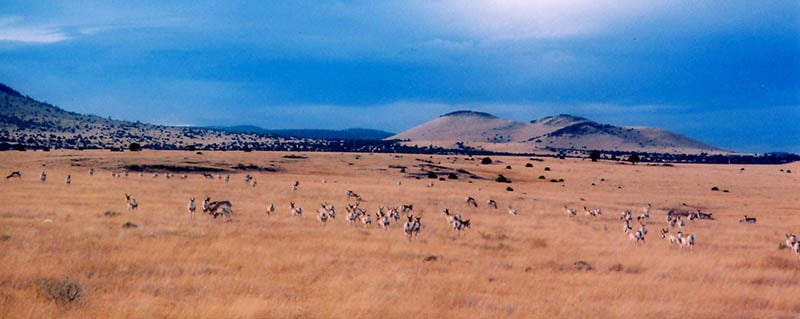
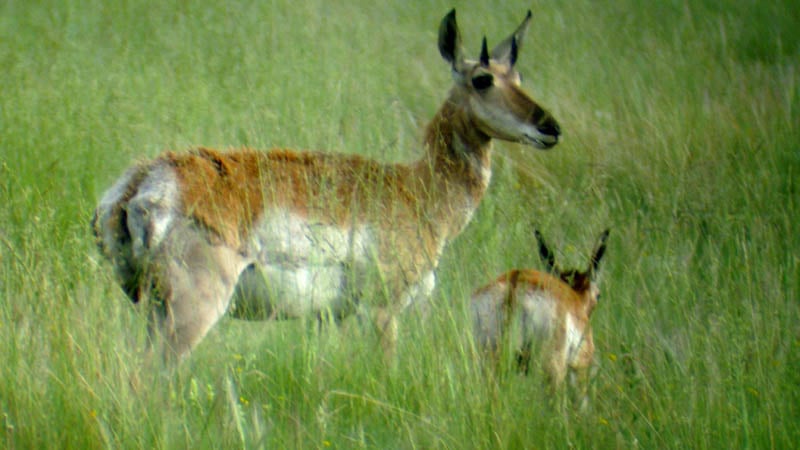

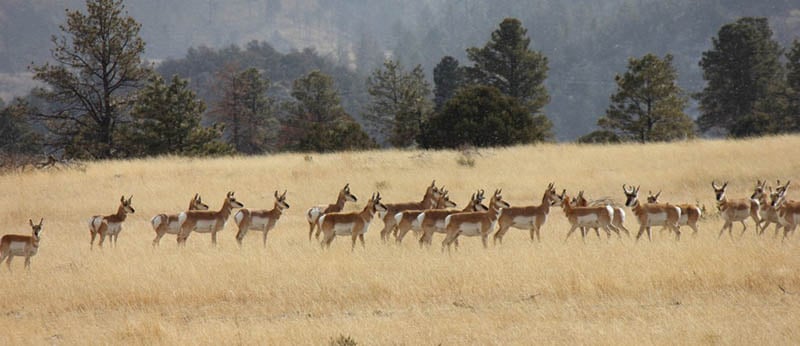




Leave a Reply